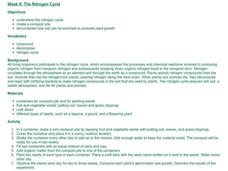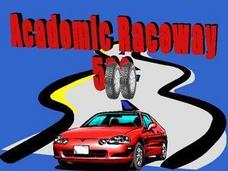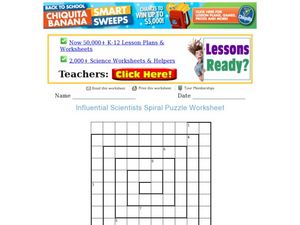Curated OER
The Nitrogen Cycle
Students design and create a compost pile in order to study the Nitrogen Cycle. They then use the scientific method to determine if plants grow better when they add organic matter from their compost pile to the plant's soil.
Curated OER
What is the Composition of Soil?
Students examine the different components that make up soil. Using data, they identify the components of soil in their local area and discover how scientists use the soil to see how it was formed. They also describe the soil forming...
Curated OER
LOSING GROUND
Students will observe wind erosion and how crop residue prevents erosion.Point out the three kinds of fields to the students. Do as much or as little instruction as needed to explain the pan with crop residue. Conservation tillage...
Curated OER
Bite Sized Core Sampling
Young scholars define the origin of rock samples and how surface core samples can tell us about the history and make-up of Mars. Candies are used as a Martian surface sample. Students study the samples and make a hypothesis about the...
Curated OER
Thermal Waters & Geologic Provinces
Pupils investigate thermal waters and geologic provinces. They examine provided maps of geothermal springs and thermal wells in the state of Idaho and their locations relative to Idaho's geologic provinces. Afterward, they use the maps...
Curated OER
Energy Resources Scavenger Hunt
In this environment worksheet, students complete each of the statements with its correct energy resource. They identify and name various types of plants and rocks. Students also identify and explain how fertilizer works and how it can be...
Curated OER
The History of Life
In this history of life activity, students complete a crossword puzzle by figuring out the vocabulary words associated with the 11 clues given. Then students review how paleontologists use fossils to learn more about past living things...
Curated OER
Totally Tundra
In this tundra activity, middle schoolers read about tundras and the plants and animals that live in tundras. They then use what they learned to answer the 10 questions on the page. The answers are on the last page.
Curated OER
Prokaryote Coloring
In this prokaryote coloring activity worksheet, 7th graders read an informative passage about prokaryotes. Students answer questions about the passage and color the picture.
Curated OER
Sunlight and Warm Air
Students discuss radiant energy from the sun, performing a simple experiment with sun glasses and bright light to demonstrate the concept. Students further participate in simple in-class experiments to demonstrate: air density as it...
Curated OER
Climate and Temperature
Students explore what the soil temperature would be on the north and south sides of a building. In this temperature instructional activity, students hypothesize what the results will be using a thermometer and then after a week...
Curated OER
Particle Size and Oil Production
Students investigate how permeable different materials are. In this physics lesson, students determine what affects permeability and how permeability relates to oil production.
Curated OER
Water Words Puzzle
In this water worksheet, students fill in the blanks to a crossword puzzle having to do with water words. Students complete 25 blanks in the crossword.
Curated OER
Academic Raceway 500: Weather
This weather PowerPoint features a game in which students advance to the finish line with a race car as they answer questions related to weather. Topics include types of clouds, weather instruments, the water cycle, and various weather...
Curated OER
Influential Scientists Spiral Puzzle
In this influential scientists worksheet, students use 8 clues given at the bottom of the page to complete a word puzzle. Worksheet contains links to additional activities.
Curated OER
Extinction of Dinosaurs
In this dinosaurs learning exercise, students review the different theories that scientist believe may have led to the extinction of the dinosaurs. This learning exercise has 18 fill in the blank questions.
Curated OER
Stratigraphy and Cross-Dating
Students interpret archaeological strata using the law of superposition. They apply cross-dating to determine the age of other artifacts.
Curated OER
Three-dimensional cooperative modeling
Middle schoolers explore what is present below the surface in order to drill into the ground and record the type of material that the drill brings to the surface. They discuss the benefits and drawbacks of distance communications. ...
Curated OER
Where to Live?
Students examine types of spatial data found in a GIS. In this geography instructional activity students use a GIS to facilitate analysis and decision making.
Curated OER
Geology of Yosemite
Students are shown slides of Yosemite and explore how the valley was formed by performing an experiment. Instructions on how to set up the lab are included. They can be assessed orally or by writing a report on the outcome of the lab.
Curated OER
Dig Magazine Archeology Quiz #60
In this Dig Magazine archeology quiz, students answer 4 multiple choice questions covering a variety of topics. Page contains answer and additional resources link.
Curated OER
Sea Surface Temperature Trends of the Gulf Stream
Students explore the importance of the Gulf Stream. Using a NASA satellite images, they examine the sea surface temperature. Students collect the temperature at various locations and times. Using spreadsheet technology, they graph the...
Curated OER
Sea Surface Temperature Trends of the Gulf Stream
Students use authentic satellite data to produce plots and graphs of sea surface temperature as they explore the seasonal changes of the Gulf Stream.
Curated OER
CO Buildup City
Students conduct a controlled experiment. They collect data in an organized manner. Students analyze data to reach a conclusion and communicate findings. They explain how city size, temperature, and pollution is related to the air quality.
Other popular searches
- Science Earth Layers
- Earth Science Earth's Layers
- Earth Science Earth Layer
- Science Layers of the Earth

























